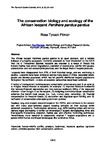The conservation biology and ecology of the African leopard Panthera pardus pardus
| dc.contributor.author | Pitman, R.T. | |
| dc.date.accessioned | 2019-05-15T14:21:55Z | |
| dc.date.available | 2019-05-15T14:21:55Z | |
| dc.date.issued | 2012 | |
| dc.identifier.citation |
Pitman, R.T. (2012) 'The conservation biology and ecology of the African leopard Panthera pardus pardus', The Plymouth Student Scientist, 5(2), p. 581-600. | en_US |
| dc.identifier.issn | 1754-2383 | |
| dc.identifier.uri | http://hdl.handle.net/10026.1/14002 | |
| dc.description.abstract |
The African leopard Panthera pardus pardus is an apex predator, and a reliable indicator of a healthy ecosystem. Currently assessed as ‗near threatened‘ by the IUCN Red List of Threatened Species, leopards are exposed to a range of threats that include: habitat loss and/or degradation, depletion of natural prey, conflict with people, consumptive- and non-consumptive practices, and the illegal trade of leopard products. Leopards have disappeared from 37% of their historical range, and are continuing to decline. Leopards have been extirpated across many areas of Africa, especially where people are densely populated, which has left patchily distributed leopard populations throughout the continent—to date, an accurate census has never been achieved. A variety of management techniques and conservation schemes are used in an attempt to mitigate threats directed at leopards; for example: (1) improved livestock husbandry that reduces livestock depredation and thus reduces retaliatory killing of the supposed offender—often thought to be the leopard, (2) designing community-based conservation schemes that benefit local people (i.e., food, money, jobs, ownership), (3) financial compensation for livestock losses, (4) ecotourism and regulated sport hunting, and (5) ratification of conservation-orientated government policies. Detailed, long-term leopard research began in the 1970‘s, and continues to the present day with many peer-reviewed papers focusing primarily on their ecology within savannah ecosystems. Technological advances (e.g., GPS tracking collars and remote camera traps) are helping to further our knowledge of leopard demographics, intra- and inter-specific interactions, predation, habitat use, and effective monitoring techniques. Nevertheless, more research is desperately required if leopard populations are to persist within human-dominated landscapes, like continental Africa. | en_US |
| dc.language.iso | en | en_US |
| dc.publisher | University of Plymouth | |
| dc.rights | Attribution 3.0 United States | * |
| dc.rights.uri | http://creativecommons.org/licenses/by/3.0/us/ | * |
| dc.subject | human-wildlife conflict | en_US |
| dc.subject | predator | en_US |
| dc.subject | bushmeat | en_US |
| dc.subject | keystone species | en_US |
| dc.subject | top-down control | en_US |
| dc.subject | umbrella species | en_US |
| dc.subject | felid | en_US |
| dc.subject | conservation | en_US |
| dc.subject | carnivore | en_US |
| dc.title | The conservation biology and ecology of the African leopard Panthera pardus pardus | en_US |
| dc.type | Article | |
| plymouth.issue | 2 | |
| plymouth.volume | 5 | |
| plymouth.journal | The Plymouth Student Scientist |



